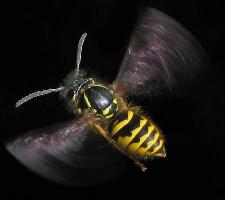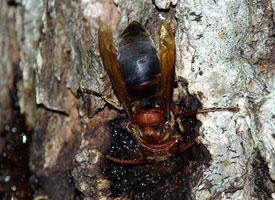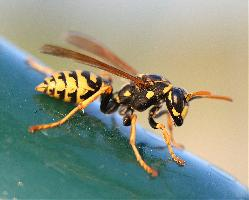
Súlyok és méretek
| Hossz | 12-tól 15-ig mm |
|---|
Állatleírás
The Common wasp (Vespula vulgaris), a member of the genus Vespula, is a widespread species of social wasp that is found across various regions of the Northern Hemisphere, including much of Europe, North America, and parts of Asia. This species is known for its distinctive appearance, complex social structure, and role in the ecosystem.Appearance: The Common wasp is characterized by its striking yellow and black body markings, which serve as a warning to potential predators of its ability to sting. Adults typically measure between 12 to 17 millimeters in length, with queens being slightly larger than the workers. They have a slender body with a narrow waist, a pair of antennae, and six legs. Their wings are transparent and can be seen folded longitudinally over their back when they are at rest. The face of the Common wasp is notable for its black and yellow markings, and they possess large compound eyes and strong mandibles for feeding and nest construction.
Nest: The nests of Vespula vulgaris are marvels of insect architecture, often built in sheltered locations such as underground cavities, hollow trees, or within the eaves and lofts of buildings. These nests are constructed from chewed wood pulp, which gives them a distinctive papery appearance. A single nest can house thousands of wasps and is organized into hexagonal cells where the queen lays her eggs. The structure of the nest and the roles within it are a testament to the complex social structure of the Common wasp.
Social Structure: Common wasps live in highly organized colonies that consist of a single breeding queen, male drones, and sterile female workers. The queen emerges in the spring to establish a new nest, laying eggs that will hatch into the first generation of workers. These workers then take over the duties of expanding the nest, foraging for food, and caring for the next generations of larvae. In late summer, new queens and drones are produced for the purpose of mating, after which the males die and the fertilized queens seek out places to hibernate through the winter, ready to start new colonies the next spring.
Diet and Ecology: The diet of the Common wasp varies throughout its lifecycle. Adult wasps primarily feed on nectar and other sugary substances, making them important pollinators for a variety of plants. However, they also hunt insects and caterpillars to feed to the larvae back in the nest, playing a crucial role in controlling pest populations. In turn, Common wasps are preyed upon by a variety of birds, mammals, and other insects.
Despite their ecological benefits, Common wasps are often viewed as pests by humans, particularly in late summer when their search for sugary foods brings them into frequent contact with human activities. Their ability to sting, sometimes repeatedly, can make encounters with these insects unpleasant and potentially dangerous for individuals with allergies to wasp venom.
In conclusion, the Common wasp (Vespula vulgaris) is a fascinating creature with a complex social structure, an intriguing diet, and a significant role in the ecosystem. While their interactions with humans can sometimes be contentious, their contribution to controlling pest populations and pollinating plants cannot be overlooked.
Hasonló állatok
Új állatfotók
Top 10 állat
- Dolphin gull (Leucophaeus scoresbii)
- Diana monkey (Cercopithecus diana)
- Moustached guenon (Cercopithecus cephus)
- Galápagos tortoise (Geochelone nigra complex)
- Japanese macaque (Macaca fuscata)
- Russian tortoise (Testudo horsfieldii)
- Stone loach (Barbatula barbatula)
- Greek tortoise (Testudo graeca)
- Common flying dragon (Draco volans)
- Vendace (Coregonus albula)


